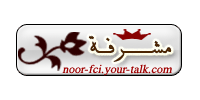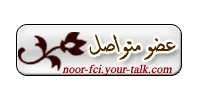 من طرف حبيبة الرحمن الجمعة 18 ديسمبر 2009 - 19:27
من طرف حبيبة الرحمن الجمعة 18 ديسمبر 2009 - 19:27
slide 5
Animation
Specify directly or
indirectly how thing moves in time and space. Creating this illusion خداع
either by hand or with the assistance of computer is not easy. Traditionally,
animation has been created by drawing images at certain key points in the
action. These images known as key-frames. Later the images between the
key-frames are filled in to complete the sequence, in a process called
in-betweening (Low level technique). For example, to key-frame hitting a
baseball, the animator would draw key moments in the sequence such as the
impact of the bat مضرب
on the ball and the follow through of the swing. The remaining images would be
filled in later, perhaps by a different animator. The most basic computer
animation tools assist the process of hand animation by automatically
interpolating between the key-frames of images.
slide 16
Two-dimensional Animation
The most common form of 2D animation is sprite
animation. A sprite is a bitmap image or set of images that are composite
over a background, producing the illusion of motion. They are usually small
with respect to the size of the screen. For example, to animate a rabbit
hopping across a meadow (أرض مخضرة), the animator would create a
sequence of images showing the rabbit hopping. This sequence of images would
then be composited one image per frame onto a background image of the meadow.
- The disadvantage of this technique is
that, slight changes in lighting and depth cannot be reproduced. Consequently,
sprite animation is most often used in interactive media where rendering speed
is more important than realism.
slide 17
Three-dimensional Animation
3D animation involves constructing a virtual world in
which objects move and interact. The animator must model, animate, and render
the 3D scene. Modeling involves describing the elements of a scene and
placing them appropriately. Animating species how the objects should
move in the 3D world. Rendering converts the description of the objects
and their motion into images.
Modeling Requirements: To animate motion, the user needs both a static description of
an object and information about how that object moves. One common way to
specify this additional information is to use an articulated مفاصل model such as the
one shown in the figure. The motion of the elbow كوع joint in a human model will affect not only
the position of the lower arm but also the position of the hand and fingers. A
second type of model used in animation is a particle جزيء system or collection
of points. The laws of physics often provide a basis for the motion. Systems
that are modeled well by particle systems include water spray, smoke, and even
flocks سرب of birds. Deformable objects are a third type of model
and include objects that do not have well-defined articulated joints. Water,
hair, clothing, and fish are among the systems that have been successfully
modeled as deformable objects.

 الاسئله والاستفسارات فى ماده ( Multimedia is.dept.)
الاسئله والاستفسارات فى ماده ( Multimedia is.dept.)










 رد: الاسئله والاستفسارات فى ماده ( Multimedia is.dept.)
رد: الاسئله والاستفسارات فى ماده ( Multimedia is.dept.)
 رد: الاسئله والاستفسارات فى ماده ( Multimedia is.dept.)
رد: الاسئله والاستفسارات فى ماده ( Multimedia is.dept.)
 رد: الاسئله والاستفسارات فى ماده ( Multimedia is.dept.)
رد: الاسئله والاستفسارات فى ماده ( Multimedia is.dept.)
 رد: الاسئله والاستفسارات فى ماده ( Multimedia is.dept.)
رد: الاسئله والاستفسارات فى ماده ( Multimedia is.dept.)
 رد: الاسئله والاستفسارات فى ماده ( Multimedia is.dept.)
رد: الاسئله والاستفسارات فى ماده ( Multimedia is.dept.)
 رد: الاسئله والاستفسارات فى ماده ( Multimedia is.dept.)
رد: الاسئله والاستفسارات فى ماده ( Multimedia is.dept.)
 رد: الاسئله والاستفسارات فى ماده ( Multimedia is.dept.)
رد: الاسئله والاستفسارات فى ماده ( Multimedia is.dept.)
 رد: الاسئله والاستفسارات فى ماده ( Multimedia is.dept.)
رد: الاسئله والاستفسارات فى ماده ( Multimedia is.dept.)
 رد: الاسئله والاستفسارات فى ماده ( Multimedia is.dept.)
رد: الاسئله والاستفسارات فى ماده ( Multimedia is.dept.)
 رد: الاسئله والاستفسارات فى ماده ( Multimedia is.dept.)
رد: الاسئله والاستفسارات فى ماده ( Multimedia is.dept.)
 رد: الاسئله والاستفسارات فى ماده ( Multimedia is.dept.)
رد: الاسئله والاستفسارات فى ماده ( Multimedia is.dept.)
 رد: الاسئله والاستفسارات فى ماده ( Multimedia is.dept.)
رد: الاسئله والاستفسارات فى ماده ( Multimedia is.dept.)
 رد: الاسئله والاستفسارات فى ماده ( Multimedia is.dept.)
رد: الاسئله والاستفسارات فى ماده ( Multimedia is.dept.)
 رد: الاسئله والاستفسارات فى ماده ( Multimedia is.dept.)
رد: الاسئله والاستفسارات فى ماده ( Multimedia is.dept.)
 رد: الاسئله والاستفسارات فى ماده ( Multimedia is.dept.)
رد: الاسئله والاستفسارات فى ماده ( Multimedia is.dept.)
 رد: الاسئله والاستفسارات فى ماده ( Multimedia is.dept.)
رد: الاسئله والاستفسارات فى ماده ( Multimedia is.dept.)